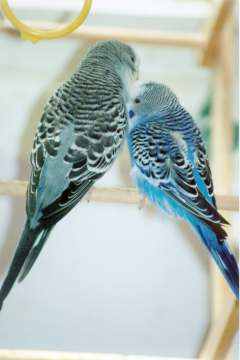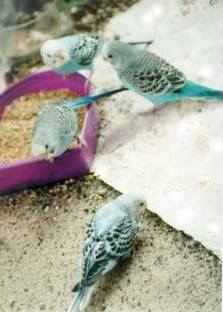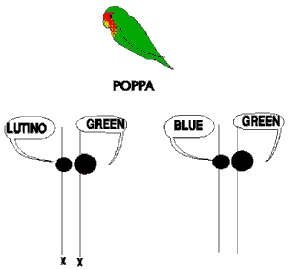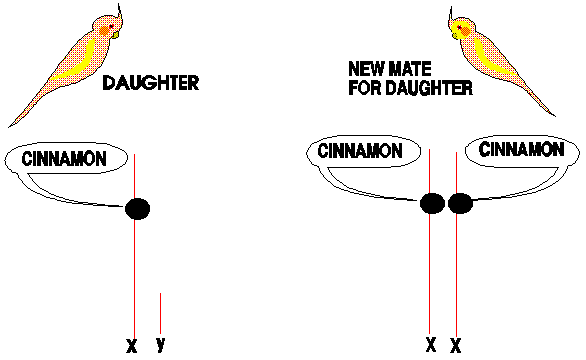
 Well, let's look at what we can see: poppa's blue and momma's grey. Isn't grey supposed to be even more dominant than green, which is more dominant than blue? So grey is WAY more dominant than blue! How did we get blue kids?
Well, let's look at what we can see: poppa's blue and momma's grey. Isn't grey supposed to be even more dominant than green, which is more dominant than blue? So grey is WAY more dominant than blue! How did we get blue kids?

 Well, let's look at what we can see: poppa's blue and momma's grey. Isn't grey supposed to be even more dominant than green, which is more dominant than blue? So grey is WAY more dominant than blue! How did we get blue kids?
Well, let's look at what we can see: poppa's blue and momma's grey. Isn't grey supposed to be even more dominant than green, which is more dominant than blue? So grey is WAY more dominant than blue! How did we get blue kids?
Momma must be split to blue. In other words, her genes must be disagreeing and the hidden blue gene is in there. She gave a blue gene to each of her kids. And poppa must have two blue genes. How do we know? Because if he had a grey or a green gene, it would be dominant. The only way he can look blue is if there are no grey or green genes around. So each baby got a blue gene from momma and one from poppa.
What happened to momma's grey gene? Why did she give all her kids that blue one? Is it stronger than we think? Well, no. It just happened by chance. It's like flipping a coin four times. You can get "heads" four times in a row easily. It doesn't mean there's anything wrong with the coin. And there's nothing wrong with mom's grey gene. It'll show up sometime in her future kids, I'm sure.
Where did the opaline come from? On the previous pages, we learned that two non-opaline parents can have opaline daughters, but not opaline sons. We also know that only poppa can be split to opaline, and that his daughters' opaline gene comes from him.
So the two opalines HAVE to be girls. And the blue poppa HAS to be split to opaline, and the grey momma HAS to be split to blue.

Let's look at what it takes to make a lutino baby from green parents. (You all know this one by now.... don't you?) You've learned that green parents can make a lutino girl baby, when the male is "split" for lutino. So my friend must have been getting lutino females from her pair. Her male must be split to lutino.
Now, how would she get blue babies, if green is dominant? Blue is not one of the genes on the sex chromosome; it's on one of the regular chromosomes. So a blue baby would need to get a blue gene from Momma and one from Poppa. (Let us all pause to make a joke about Baby getting a pair of blue genes...) Baby could get a blue gene from each parent if each parent was split to blue. Therefore, the pair must BOTH be split to blue.
Now, let's look at those sets of genes: the ones on the sex chromosome and the ones needed to make blue:
Here's Momma split to blue and Poppa split to blue and lutino:


Let's look at ALL the different ways these genes could combine to make a baby:
1. Momma can give her X chromosome and her blue gene chromosome.
2. Momma can give her X chromosome and her green gene chromosome.
3. Momma can give her y chromosome and her blue gene chromosome.
4. Momma can give her y chromosome and her green gene chromosome.
1. Poppa can give his lutino X chromosome and his blue gene chromosome.
2. Poppa can give his lutino X chromosome and his green gene chromosome.
3. Poppa can give his green X chromosome and his blue gene chromosome.
4. Poppa can give his green X chromosome and his green gene chromosome.
Now if we combine Momma's contribution with Poppa's contribution, we can see all the different combinations of genes that a baby of theirs could have. That's a lot of different combinations (sixteen, to be exact), and we're just looking at two of the genes! But let's see what we get if we combine the first possibility from Momma's list with the first possibility from Poppa's.
-The baby would get two X chromosomes, so it is a boy.
-He would get one green X chromosome (from Momma) and one lutino X chromosome from Poppa, so he'd be split to lutino.
-He'd have a blue gene from each parent, so he'd look blue.
We could continue to combine Momma's possible contributions with Poppa's contributions to find all the different possibilities for a baby. Let's not; you can do it if you like, as an exercise. I would like to point out just one of the combinations that is especially interesting. What do we get with Momma's 3rd possibility and Poppa's first one?
The baby would have one y chromosome, so it would be a girl. It would have a lutino X chromosome from Poppa, so it would be lutino. It would have two blue genes, one from each parent, so it would be blue. How can it be blue and lutino at the same time????
Blue genes work by telling the feathers not to make yellow coloring. Blue lovebirds are lovebirds who have hardly any yellow color. (They have some yellow, so the blue is not all that blue, but they're still called blue...) Lutino genes work by telling the feathers not to make any blue/black coloring. So in this example, we have genes telling the bird not to make any blue/black or yellow coloring... what's left? Not much. A budgie in this situation would be albino. In peach faced lovebirds, it's still got a little bit of creamy coloring so it's called creamino.
Not only can this pair of birds make blues, greens, and yellows, but they can make creaminos as well! But only one of the sixteen different gene combinations gives a creamino. This means there won't be very many creamino babies coming from the pair, though it IS possible for them to make some.
So what did I tell my friend? That her birds are both split to blue, that the male is split to ino (we better just call it "ino" since he can make both lutino and creamino out of it!), and that she should get a creamino female every now and then! (She did, in the very next clutch).

What do we know about cinnamon? It's one of those sex-linked genes. So what can a split-to-cinnamon poppa give you? Cinnamon daughters. (Remember, he will give you normal (non-cinnamon) sons and daughters, also).
So he mates and has no cinnamons in his first clutch. Were you gypped? Not necessarily. Nobody guarantees the genes will combine the way you want them to in every clutch. But you ought to see cinnamons in one of the first few clutches.
In his second clutch, there is a cinnamon. We know it has to be female. You decide to keep her. Then you go to a bird fair where there are a lot of cinnamon budgies (or tiels) for sale. You have only money and space enough to buy one bird. What do you buy?
You could buy Poppa a cinnamon female, or you could buy Daughter a cinnamon male. Is there a difference in what you can do with each? Yes.
Getting Poppa a cinnamon hen gives you the following genes:

Whenever Poppa gives his normal gene, we'll have normal-colored babies. And so we can get cinnamon males, cinnamon females, normal males and normal females. Basically, about half of the clutch is going to be cinnamon and half will be normal.
If we get a male for Daughter, we have the following genes:

And you can see that every baby will be cinnamon. So if you want cinnamons, you'll do better to get a male for Daughter.
You could always just breed Poppa to Daugher, but that is just like the example above, getting Poppa a cinnamon mate. It doesn't give you as many cinnamons as if you get Daughter a cinnamon mate. Besides, inbreeding can have nasty side effects, like babies with rare health problems, defects, etc.
